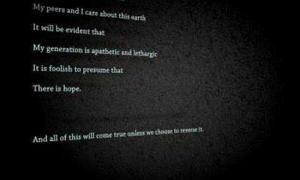Turn your words and images into audience-velcro!
March 31, 2009
In public speaking, there’s an endless argument: How to make PowerPoint really work for audiences. Some people say the solution is fewer slides. Or less complex slides. Or more graphically attractive slides.
I say they’re missing a big point. You can have just a few, simple, gorgeous visuals. And your audience can still get completely lost.
For your audience to create real meaning that sticks with them, they’ve got to be able to constantly tie together what you’re saying and what they’re seeing. Your words and visuals need to reinforce each other in ways that make sense at every moment. Not on the next slide. Not in the next paragraph. At every moment.
It’s really a shame that PowerPoint gets blamed for so many poorly received presentations. After all, PPT is just a tool—another medium for conveying information. It’s what presenters do with it that matters. Does MS Word get blamed for lousy writing? Nope. And you’ll note that Bernie Madoff’s lawyers didn’t try an “Excel spreadsheet defense.”
The real reason why many PPT-based presentations don’t work is this. To the audience, the speaker’s words and the visuals on the screen are out of sync.
Let’s say you’re giving a presentation and “out of sync” happens to you. Your audience starts working hard to solve the problems you’re creating. Eyeballs begin bouncing back and forth between you and the screen.
When your audience members can’t get words and images into sync, they face two choices.
Choice #1: Audience members who aren’t motivated (a large percentage) just tune out. BlackBerrys appear. Work comes out of briefcases. Mentally, your audience has walked out on you.
Choice #2: Audience members who really want to understand what you’re communicating (a small percentage) listen to you and ignore the screen. Or they watch the screen and ignore you.
As a speaker, when Choices #1 and #2 kick in, you’re pushing a big rock up a steep hill.
It doesn’t take much for this to happen. They say football is a game of inches. In the same way, getting words and images working together, in sync, is a game of seconds. Not minutes. Seconds.
I’ve developed “The Synchronicity Method” for turning your words and visuals into Velcro that grabs your audience and attaches your big ideas to their hearts and minds.
Here’s how it works. When your spoken words and visual images are completely in sync, your audience is right with you. They’re taking two separate forms of content—verbal and visual—and weaving them together into a fabric of ideas. Your audience is creating meaning for themselves. They love this. Their brains are working. They’re actively participating in your presentation.
The Synchronicity Method produces a multiplier effect in your presentation. 1+1 = 3. Your words and images build meaning, layer on layer. Audience members nod their heads in understanding. They say to themselves, “OK, I get it. I’m with you.”
So how can you use The Synchronicity Method in your next presentation? It comes down to how you preserve linkage while creating both verbal tools (your script or outline) and visual tools (your individual slides.) Here’s a four-step process that locks together words and images.
First, get your important blocks of information down on paper. Note cards or Post-Its are flexible formats that let you easily shuffle ideas to create a flow that works for the audience. Getting this step buttoned up is not just a huge timesaver. It becomes the road map for everything that follows.
Second, develop a bullet point outline or script to flesh out the important information blocks. At this stage, keep it brief.
Third, in your outline or script, literally highlight the big ideas that lend themselves to powerful, persuasive visualization. You’ve now got a list of visuals to be created or modified from existing content. Big point to remember: words first, then visuals. This working process is standard operating procedure for megabuck feature films. Let it work for you.
Four, as your presentation is edited and modified, always work with a single document that has both words and visuals next to each other. This way, synchronicity between words and visuals never gets lost.
PowerPoint can be a terrific tool to help your audience understand and believe your message. An all-too-common problem is that lots of people become lost in the idea that PowerPoint is the presentation.
You can get hands-on experience using this process in my one-day, on-site Synchronicity Method Workshop. To learn more, e-mail me at the address below.
Pete Ryckman is a veteran speechwriter with 24 years of writing at the CEO level. He’s developed more than 800 speeches and presentations for executives at Westinghouse Electric and Autodesk, the maker of AutoCAD. Pete is a graduate of Carnegie-Mellon’s School of Design. He may be reached at [email protected].


